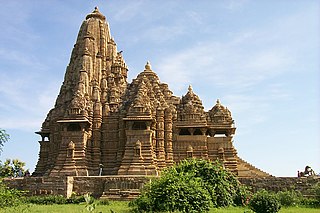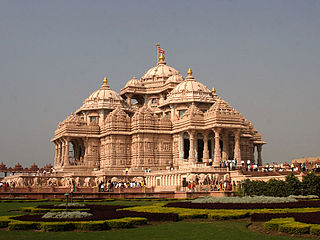Related Research Articles

The Hoysala Kingdom was a Kannadiga power originating from the Indian subcontinent that ruled most of what is now Karnataka between the 10th and the 14th centuries. The capital of the Hoysalas was initially located at Belur, but was later moved to Halebidu.

Indian architecture is rooted in the history, culture, and religion of India. Among several architectural styles and traditions, the best-known include the many varieties of Hindu temple architecture and Indo-Islamic architecture, especially Rajput architecture, Mughal architecture, South Indian architecture, and Indo-Saracenic architecture. Early Indian architecture was made from wood, which did not survive due to rotting and instability in the structures. Instead, the earliest existing architecture are made with Indian rock-cut architecture, including many Buddhist, Hindu, and Jain temples.

Hindu temple architecture as the main form of Hindu architecture has many different styles, though the basic nature of the Hindu temple remains the same, with the essential feature an inner sanctum, the garbha griha or womb-chamber, where the primary Murti or the image of a deity is housed in a simple bare cell. For rituals and prayers, this chamber frequently has an open space that can be moved in a clockwise direction. There are frequently additional buildings and structures in the vicinity of this chamber, with the largest ones covering several acres. On the exterior, the garbhagriha is crowned by a tower-like shikhara, also called the vimana in the south. The shrine building often includes an circumambulatory passage for parikrama, a mandapa congregation hall, and sometimes an antarala antechamber and porch between garbhagriha and mandapa. In addition to other small temples in the compound, there may be additional mandapas or buildings that are either connected or separate from the larger temples.
The Qutb Minar, also spelled Qutub Minar and Qutab Minar, is a minaret and "victory tower" that forms part of the Qutb complex, which lies at the site of Delhi's oldest fortified city, Lal Kot, founded by the Tomar Rajputs. It is a UNESCO World Heritage Site in the Mehrauli area of South Delhi, India. It was mostly built between 1199 and 1220, contains 399 steps, and is one of the most visited tourist spots in the city. Qutab-ud-din Aibak initiated construction of the Qutub Minar, but only managed to finish the first level. His later rulers continued the construction, and in 1368, Firuz Shah Tughlaq rebuilt the top parts and added a cupola.

Ratan Parimoo is an Indian art historian from Kashmir, who has worked as an art educator, pedagogue, artist and former director of the Lalbhai Dalpatbhai Museum, Ahmedabad. Ratan Parimoo was one of the founder members of Baroda Group.

A Hindu temple, also known as Mandir, Devasthanam, Pura, or Koil, is a sacred place where Hindus worship and show their devotion to deities through worship, sacrifice, and prayers. It is considered the house of the god to whom it is dedicated. Hindu temple architecture, which makes extensive use of squares and circles, has its roots in Vedic traditions, which also influence the temples' construction and symbolism. Through astronomical numbers and particular alignments connected to the temple's location and the relationship between the deity and the worshipper, the temple's design also illustrates the idea of recursion and the equivalency of the macrocosm and the microcosm. A temple incorporates all elements of the Hindu cosmos—presenting the good, the evil and the human, as well as the elements of the Hindu sense of cyclic time and the essence of life—symbolically presenting dharma, artha, kama, moksha, and karma.

Swaminarayan Akshardham is a Hindu temple and spiritual-cultural campus in Delhi, India. The temple is close to the border with Noida. Also referred to as Akshardham Temple or Akshardham Delhi, the complex displays millennia of traditional and modern Hindu culture, spirituality, and architecture. Inspired by Yogiji Maharaj and created by Pramukh Swami Maharaj, it was constructed by BAPS. It is the world's second-largest BAPS Hindu temple, following Akshardham, New Jersey, in the United States.

Bhumija is a variety of north Indian temple architecture marked by how the rotating square-circle principle is applied to construct the shikhara on top of the sanctum. Invented about the 10th-century in the Malwa region of central India during the Paramara dynasty rule, it is found in Hindu and Jain temples. Most early and elegant examples are found in and around the Malwa region, but this design is also found in Gujarat, Rajasthan, Deccan and some major Hindu temple complexes of southern and eastern India.

The Mānasāra, also known as Manasa or Manasara Shilpa Shastra, is an ancient Sanskrit treatise on Indian architecture and design. Organized into 70 adhyayas (chapters) and 10,000 shlokas (verses), it is one of many Hindu texts on Shilpa Shastra – science of arts and crafts – that once existed in 1st-millennium CE. The Manasara is among the few on Ancient Indian architecture whose complete manuscripts have survived into the modern age. It is a treatise that provides detailed guidelines on the building of Hindu temples, sculptures, houses, gardens, water tanks, laying out of towns and other structures.

The Kasivisvesvara temple, also referred to as the Kavatalesvara, Kashivishveshvara or Kashi Vishvanatha temple of Lakkundi is located in the Gadag district of Karnataka state, India. It is about 12 kilometres (7.5 mi) from Gadag city, between Hampi and Goa. The Kasivisvesvara temple is one of the best illustrations of fully developed Kalyana Chalukya style of Hindu architecture.

India and Indonesia established diplomatic relations on 16 April 1949. Both countries are neighbours, India's Andaman and Nicobar Islands share a maritime border with Indonesia along the Andaman Sea.
Michael W. Meister is an art historian, archaeologist and architectural historian at the University of Pennsylvania. He is the W. Norman Brown Professor in the Department of History of Art and South Asia Studies, and has served as chair of the Department of South Asia Studies and as the director of the University of Pennsylvania's South Asia Center. In addition, he is Consulting Curator, Asian Section, University of Pennsylvania Museum of Archaeology and Anthropology, and Faculty Curator of the South Asia Art Archive within the Penn Library's South Asia Image Collection.
Soumyen Bandyopadhyay is an architect and architectural historian at Liverpool University where he was head of department and holds the Sir James Stirling Chair in Architecture. He has previously held professorial positions at the Manchester School of Architecture (MSA) and Nottingham Trent University.

Heinrich von Stietencron was a German Indologist. During his academic career, he was an emeritus professor and the chair of the Indology and Comparative Religion department at the University of Tübingen.
Deborah Klimburg-Salter is an art historian and emeritus professor for non-European art history at the Department of Art History of the University of Vienna. She was also director of the research platform Center for Research and Documentation of Inner and South Asia (CIRDIS). Currently she directs the project "Cultural Formation and Transformation: Shahi Art and Architecture from Afghanistan to the Western Frontier at the Dawn of the Islamic Era" financed by the Austrian Science Fund (FWF) and dedicated to transdisciplinary research.

The American Institute of Indian Studies (AIIS), founded in 1961, is a consortium of 90 universities and colleges in the United States that promotes the advancement of knowledge about India in the U.S. It carries out this purpose by: awarding fellowships to scholars and artists to carry out their research and artistic projects in India; by operating intensive programs in a variety of Indian languages in India; by sponsoring conferences, workshops and outreach activities; by supporting U.S. study abroad and service learning programs in India; by assisting and facilitating the research of all U.S. scholars in India; and by operating two research archives, the Archives and Research Center for Ethnomusicology and the Center for Art and Archaeology. The AIIS is a member of the Council of American Overseas Research Centers.

The Durga temple is an early 8th-century Hindu temple located in Aihole, Karnataka, India. Originally dedicated to Surya, it has the most embellished and largest relief panels in Aihole depicting artwork of Shaivism, Vaishnavism, Shaktism and Vedic deities. Apart from its fine carvings, it is notable for its apsidal plan – a rare example among early Chalukyan Hindu temple architecture.

Professor Anvita Abbi is an Indian linguist and scholar of minority languages, known for her studies on tribal languages and other minority languages of South Asia. In 2013, she was honoured with the Padma Shri, the fourth highest civilian award by the Government of India for her contributions to the field of linguistics.
Pushkar Sohoni is an architect, and an architectural and cultural historian. He is an associate professor in the department of Humanities and Social Sciences at the Indian Institute of Science Education and Research, Pune. He was Chair of the department from 2019 to 2024.
References
- 1 2 Royal Grammar School, High Wycombe: School List for 1970
- ↑ "Welsh School of Architecture: Hardy Profile". Cardiff University. Archived from the original on 14 February 2012. Retrieved 18 July 2011.
- ↑ "BASAS: South Asian Studies". BASAS. Archived from the original on 30 September 2018. Retrieved 18 July 2011.
- ↑ "PRASADA: Home". PRASADA. Archived from the original on 2 November 2011. Retrieved 18 July 2011.
- ↑ "BASAS: Home". BASAS. Archived from the original on 26 July 2011. Retrieved 18 July 2011.
- ↑ "EASAA: Home". EASAA. Archived from the original on 29 May 2013. Retrieved 18 July 2011.
- ↑ "Robinson A (2008) Review: The Temple Architecture of India By Adam Hardy, World Archeology, issue 31 page: 64". Current Publishing. Archived from the original on 26 September 2011. Retrieved 18 July 2011.